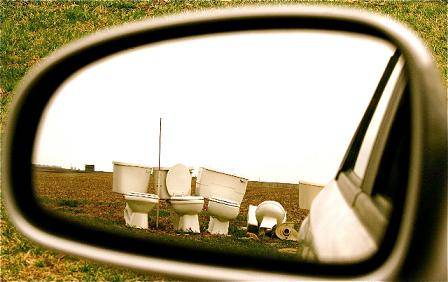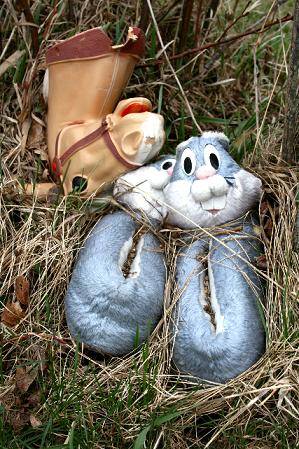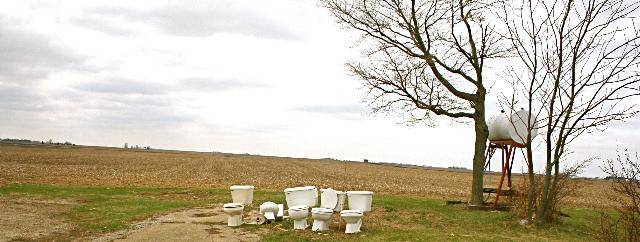
Five Short Reflections (and a footnote):
1) Five abandoned toilets sit side by side under a pair of scraggly trees. The white porcelain is vivid against the gray sky, all of it backed by acres and acres of a stubbled March cornfield.
I’m on Route 47 headed south, a mile or two from I-74, on a drive I take every week. I know all the weathered, tilting barns and crumbling farm houses between Mahomet and Dwight. I know the cemeteries and gas station restrooms. This is the first time I’ve seen these five roadside toilets. No one is using them, so I decide to stop.
2) When I turn the car onto the cracked driveway, I feel like I’ve entered a family cemetery with four standing tombstones and one broken marker, fallen on its back. But these are not markers of anyone specific. One of them may have a date stamped on the bowl, but no one has left flowers.
From the road, the commodes commanded my attention. Close up, these are waste; garbage waiting to be picked up. Two appear to have tanks and bowls without cracks. Someone would like these old 3.5 gallon tanks, impossible to get now. The beige one from the 80s looks most likely to be resurrected. Some of the seats are left up, some of the lids are closed.
Wherever I stand, they make me smile. From one side they look like mouths, some smiling, some closed. From the other side they appear to have popped from the ground like wild mushrooms. From behind they give an irreverent salute to the drivers.
I don’t touch the toilets, but I get close enough to take photographs. They smell wet, though several are surprisingly clean. One bowl has a striped pattern of stains (please let them be rust stains), like an abstract painting inside a sculpture — R. Mutt taken up a notch.
The art may be accidental, but the guy who unloaded these toilets from his pickup truck, lined them up this way like he meant it: Duchamp the handy man. I take pleasure in the arrangement, like I put it all together myself. Which is what strikes me about the whole ridiculous scene: all of it looks to be arranged. Somebody ordered this scene, maybe even the guy who planted the fields.
3) Other than the toilets, the most vivid emblems of human presence: a pair of matching bunny slippers and a plastic horse head in the grass. If I think of this as a cemetery, they could be a memorial to a child. If I think of it as a home, they are what’s left from the final garage sale. If I labor a little less to make meaning, they are, like the toilets, useless junk in dead grass near a tree.
4) The small house that once stood here has been reduced to a pile of dirt, weeds, and metal, with a few silvered logs, thick and short, arranged around one end. It is mostly rusted metal on a concrete slab. Maybe Larry Kanfer or Ray Bial could make it artful, but there is no light, no angle of observation that I can find to make a meaningful photograph. I circle the heap of stuff. I walk far away, then come closer and closer. I bend down to look at the wasting objects, looking for evidence of a fire or the twisted signs of a tornado. Several lie in the wet grass. I adjust all the settings on my camera (at least the ones I understand). The light, the lens, the rusted stuff offer nothing.
Perhaps if I had waded ankle deep into the wreckage I would have seen things. But, I didn’t feel like acquiring tetanus. Perhaps from the top of the rubble the fields would have said something like “This shouldn’t have been here in the first place” or “Look at the mess everyone will leave in some way.” But when I turned my back on the pile of human junk, when I listened for a bit, there was mute wind; the fields said, as they usually do, nothing.
5) Often I read meaning into landscapes — the trees have arms; the sunset bleeds; rain clouds brood. All of this is imagination and projection and I know it. The places I know may speak sometimes, but I probably have no idea, speeding through them as I do. Jesus said to “consider the lilies of the field,” they have things to teach us about toil and worry and beauty. But I was slowed down and drawn to the toilets simply because they are human-made objects, the kinds of things that organize my world, whether or not they should.
When Wallace Stevens placed a jar in Tennessee, he saw it ordering “the slovenly wilderness” and taking “dominion every where.” A mason jar. Really? What might a whole row of commodes have done to reorder his landscape, his universe?

Footnote: Do an image search online for “abandoned toilets.” Blessedly, most of the toilets are empty. But sometimes you find a full one, bowl and tank alike, used as pots for flowers. There are certainly worse things a body could leave in such a place by the road.








